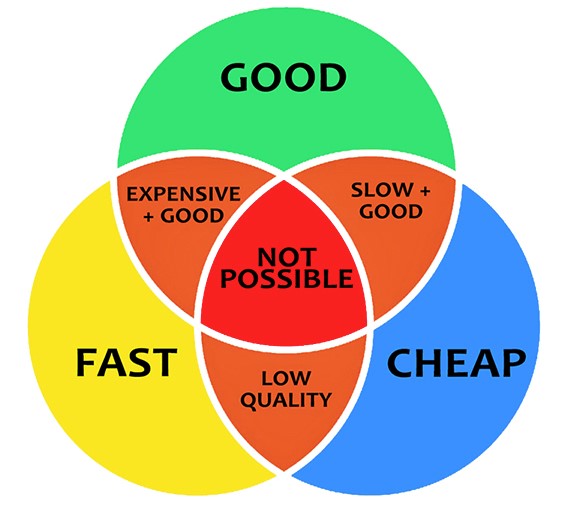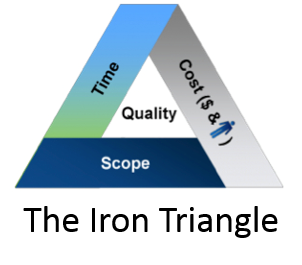Understanding the Importance of Knowing the HCM Implementation Approach of Your Service Provider
The first time I saw the phrase “Good, Fast or Cheap” I was at a restaurant in Washington, D.C. The phrase was hanging on the wall, framed, visible for all to read. At the time, I didn’t relate the phrase to what I did for a living, which is to help businesses with the implementation of HR software solutions and educating them on the HCM implementation approach my firm utilizes and why this approach is important and how it leads to success.
Years later I was reminded of the phrase when my firm began the process of purchasing and implementing our new website. Building a new website was going to be a big project for us and we were apprehensive about the implementation costs, the time it was going to take to build the site, the experience of the vendor’s project team and the scope of work we were requesting of the vendor. It was during this project the phrase “Good, Fast or Cheap” hit home for me. My firm had to make a choice in the type of implementation we wanted for our new website. We quickly learned we could not have a “Good, Fast and Cheap” implementation collectively. This simply was not possible. I also realized that the concerns we were having about cost, time and resources were similar to the concerns of our clients. The only difference was my firm was having a new website built where as our clients are implementing new HR software solutions. And I know all too well that they too cannot have a good, fast and cheap HCM implementation approach if they want to have a successful outcome.
The phrase “Good, Fast or Cheap”, also known as “The Iron Triangle”, emerged over time from the thinking that you can only choose two of the three; and that you cannot successfully have all three.
I think these examples illustrate the concept best.
• Design something fast and with high quality, it will not be cheap.
• Design something fast and cheap, it will not be of high quality.
• Design something with high quality and cheap, it will not be fast.
Regardless of the vendor’s implementation approach or resources available, you must inevitably select just two of the three general properties (i.e. Good, Fast or Cheap). Why? The trio of project constraints (i.e. time, resources and scope) are always limited in one form or another. The reality is that “Good, Fast and Cheap” combined does not exist. This three intersecting circles diagram reflects the fact that the three primary constraints of a project are interrelated, and it is not possible to optimize all three – one will always suffer. In other words, you have three options, but only two choices. And whenever one of the constraints is modified, the other two constraints will be impacted.
In today’s economy, consumers are accustomed to instant gratification, whether it be instant access to products or immediate delivery of services. Out of “Good,” “Fast,” and “Cheap,” the “Fast” option is becoming more prevalent, and this holds true for HCM implementation approaches. As evidence of this ‘fast’ mentality is the birth of the term “quick-start”, “fast-start”, “fast-track”, and “express” in relation to how HRIS/HCM vendors are describing, packaging and selling their services. The market demand is forcing HRIS/HCM vendors to come up with ways to accelerate the delivery of their services. Unless you have negotiated something specific with your HRIS/HCM vendor, most providers start the clock running on the day the sales order is executed, increasing the urgency to quicken the implementation. I’ve seen far too many times organizations focus on the ‘fast’ approach only to be disappointed with the results and eventually spending more money by needing to re-visit, re-configure and re-implement to get their desired outcome. As the old saying goes, it pays to do it right the first time.
As I have written in the past, this “fast” approach tends to commoditize the professional services and not deliver on the project outcomes. My blog “Buyers Beware: The Commoditization of Professional Services” describes this driving trend.
From my firm’s perspective, what clients want is the “Good” or “Quality” component of the ‘Iron Triangle’. When they contract with us for implementation services, they want the acquired application to work as advertised, they want it to last a long-time and they don’t want to encounter any issues with the quality of work delivered (i.e. errors, issues, mistakes, etc.). Therefore, it is always our recommendation to take a little extra time and spend a little extra money to ensure that the “Good” portion of the “Iron Triangle” is not diluted. This includes or encompasses areas like upfront planning, a comprehensive statement of work and thorough application training. We believe this upfront planning and extra effort will make all the difference between a successful or failed implementation.
I’ll end with a couple of recommendations. As you go through your HRIS/HCM evaluation process, ask a lot of questions. Ask questions during the vendor demonstrations, during follow-up conversations, during the statement of work review and during the contract review process. Require an in-depth statement of work (SOW) from the vendor that describes in detail what will be configured and delivered during implementation. The golden rule here is if it doesn’t say it in the vendor’s SOW, it won’t be delivered and you aren’t getting it. Finally, pay close attention to the vendor’s overall attitude to the implementation process, their methodology. You will see and learn fairly quickly which HCM implementation approach (i.e. good & fast, fast & cheap or cheap & good) they have adopted and follow. Does this approach align with the results you want in the end? If not, keep looking for a firm that delivers the approach and outcome you desire.
Request Your Free HRIS Vendor Comparison Report Today
Author’s Note: This post was originally published in February 2017 and has been updated for accuracy and comprehensiveness.





